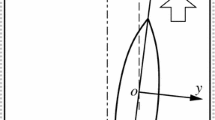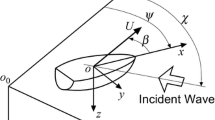Abstract
Nowadays, there are many studies conducted in the field of marine hydrodynamics which focus on two vessels traveling and floating in sufficiently close proximity to experience significant interactions. The hydrodynamic behavior of parallel moving ships in waves is an interesting and important topic of late. A numerical investigation has been carried out for the prediction of wave exciting forces and motion responses of parallel moving ships in regular waves. The numerical solution was based on 3D distribution technique and using the linear wave theory to determine the exciting forces and ship’s motion. The speed effects have been considered in the Green function for more realistic results. The numerical computations of wave exciting forces and motion responses were carried out for a Mariner and Series 60 for the purpose of discovering different Froude numbers and different separation distances in head sea conditions. Based on the numerical computations, it was revealed that the sway, roll and yaw have a significant effect due to hydrodynamic interaction.
Similar content being viewed by others
References
Chen Gungrong, Fang Mingchung (2001). Hydrodynamic interactions btween two ships advancing in waves. Ocean Engineering, 28, 1053–1078.
Duncan JH, Barr RA, Liu YZ (1983). Computations of the coupled response of two bodies in a seaway. International Workshop on Ship and Platform Motions, Berkley, USA.
Fang MC (1987). On the diffraction program between two ships advancing in an oblique sea. International Shipbuilding Progress, 34(396), 146–159.
Guo Z, Chang AT (1993). Boundary integral computation of hydrodynamic interactions between a 3-dimensional body and an infinitely long cylinder. Journal of Ship Research, 37(4). 281–297.
Islam MR (2001). A study on motions and non-linear second order drift forces of multi-body floating systems in waves. PhD Thesis, Yokohama National University, Yokohama, Japan.
Kodan N (1984). The motion of adjacent floating structures in oblique waves. The 3rd International Symposium on Offshore Mechanics and Arctic Engineering, New Orleans, 206–213.
Korsmeyer FT, Lee CH, Newman JN (1993). Computation of ship interaction forces in restricted waves. Journal of Ship Research, 37(40), 298–306.
Ohkusu M (1969). On the heaving motion of two circular cylinders on the surface of a fluid. Reports of the Research Institute of Applied Mechanics, Kyushu University, Japan, 17(58). 167–185.
Ohkusu M (1970). On the motion of multi hull ship in waves. Journal of the Society of Naval Architects of West Japan, 40, 19–47.
Ohkusu M (1976). Ship motions in vicinity of a structure. Proceedings 1st International Conference on the Behaviour of Offshore (BOSS ′76), Trondheim, 284–306.
Ohkusu M (1996). Hydrodynamics of ships in waves. In: Advances in Marine Hydrodynamics. Computational Mechanics Publications. Southampton, UK, 77–131.
STCW (1995). An amendment to the international convention on standards of ttraining, certification and watch-keeping for seafarers. IMO, London.
McTaggart K, Cumming D, Hsiung CC, Lin Li (2003). Sea-keeping of two ships in close proximity. Ocean Engineering, 30, 1051–1063.
Ursell F (1949). On the heaving motions of a circular cylinder on the surface of a fluid. Quarterly Journal of Mechanics and Applied Mathematics, 2, 218–231.
Van Oortmerssen G (1979). Hydrodynamic interaction between two structures floating in waves. 2 nd International Conference on Behaviour of Offshore Structures (BOSS ′79), London, 339–356.
Wehausen JV, Laitone EV (1960). Surface waves. Encyclopedia of Physics, 9, 446–778.
Wu Jiankang, Lee TS, Shu C (2001). Numerical study of wave interaction by two ships moving parallel in shallow water. Computational Methods Applied Engineering, 190(15–17), 2099–2110.
Author information
Authors and Affiliations
Corresponding author
Additional information
Dr. M. Rafiqul Islam was born in 1969. He is a professor of Naval architecture and Marine Engineering. Currently, he is the editor of Bangladesh Maritime Affairs and associate editor of Journal of Naval Architecture and Marine Engineering. His research include collision dynamics, dynamics of offshore structures, multi-body floating dynamics, port and harbor engineering, mooring analysis, etc.
Dr. Motohiko Murai was born in 1970. He obtained his PhD from the University of Tokyo. Currently, he is the associate professor at Yokohama National University, Japan. His research field include hydrodynamic and hydro-elastic problem of floating structures utilization of ocean renewable energy by floating systems.
Rights and permissions
About this article
Cite this article
Islam, M.R., Murai, M. Dynamic interaction of parallel moving ships in close proximity. J. Marine. Sci. Appl. 12, 261–271 (2013). https://doi.org/10.1007/s11804-013-1205-y
Received:
Accepted:
Published:
Issue Date:
DOI: https://doi.org/10.1007/s11804-013-1205-y




